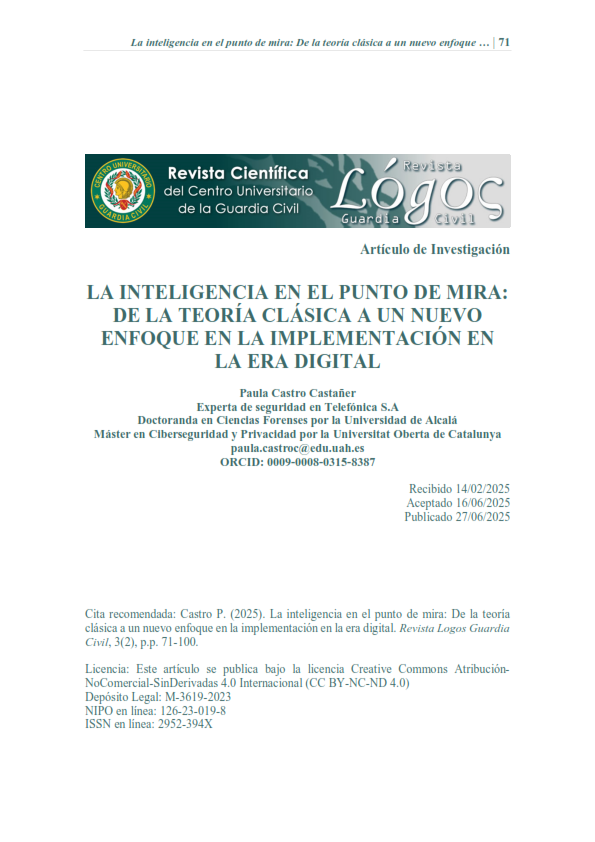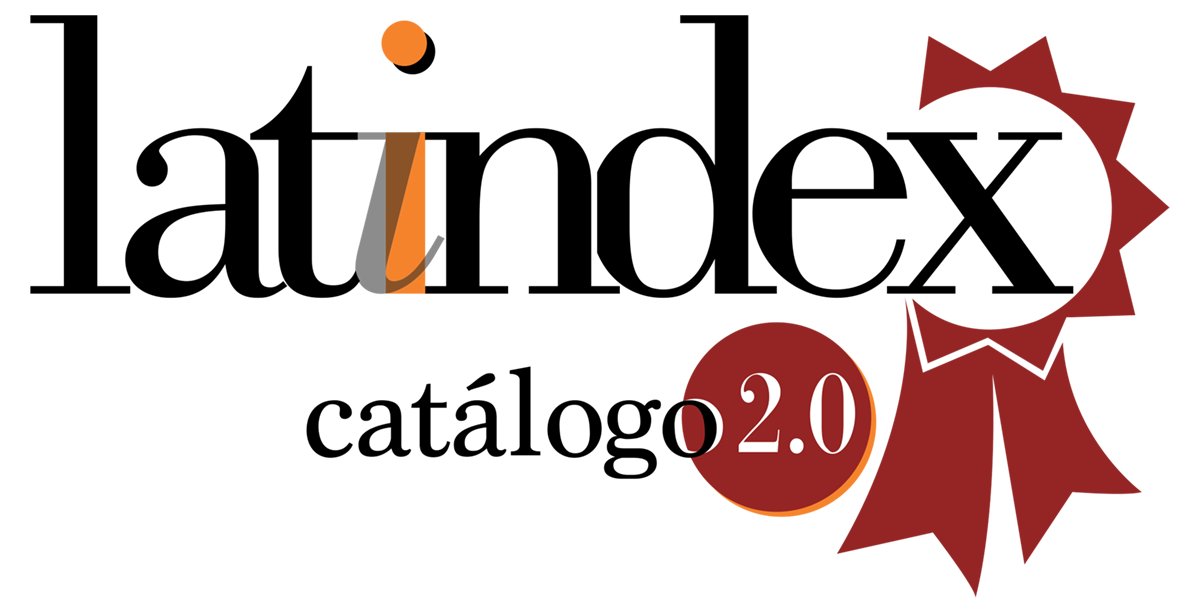La inteligencia en el punto de mira: de la Teoría Clásica a la implementación en la Era Digital
Palabras clave:
Amenazas cibérneticas, Ciberinteligencia, ciclo de inteligencia, modelo IDEM, enfoque en redResumen
Este artículo aborda la evolución de la inteligencia en el ámbito de la Defensa y Seguridad, desde los enfoques tradicionales hasta su adaptación a la era digital, estableciendo una propuesta que mejore el actualmente criticado ciclo de inteligencia. Para ello se exploran conceptos clave como la definición del concepto de inteligencia, los diferentes tipos de inteligencia e incluso el tradicional ciclo de inteligencia y sus fases. Además, se presenta una revisión de la evolución y de los diferentes enfoques que se han ido adoptando a lo largo de la historia en materia de inteligencia. Por último, se propone un modelo de inteligencia, denominado IDEM, que combine el talento del analista humano y el procesamiento automatizado de grandes volúmenes de datos para garantizar una inteligencia proactiva, adaptativa y de calidad ante las complejas amenazas cibernéticas transnacionales.
Descargas
Citas
8. REFERENCIAS BIBLIOGRÁFICAS
Andric, J., & Terzic, M. (2023). Intelligence cycle in the fight against terrorism with usage of OSINT data. Journal of Information Systems & Operations Management, 17(1). https://doi.org/10.1080/2158379X.2021.1879572
Atwood, C. P. (2015). Activity-Based Intelligence Revolutionizing Military Intelligence Analysis. Joint Force Quarterly, 77. https://ndupress.ndu.edu/Media/News/Article/581866/activity-based-intelligence-revolutionizing-military-intelligence-analysis/
Budhram, T. (2015). Intelligence-led policing: A proactive approach to combating corruption. South African Crime Quarterly, 52. https://doi.org/10.17159/2413-3108/2015/i52a30
Carter, J. G., & Fox, B. (2019). Community policing and intelligence-led policing: An examination of convergent or discriminant validity. Policing: An International Journal, 42(1), 43–58. https://doi.org/10.1108/PIJPSM-07-2018-0105
Centro Criptológico Nacional. (2015). CCN-STIC-425 Ciclo de Inteligencia y Análisis de Intrusiones.
Centro Nacional de Inteligencia. (2023). Origen de los Servicios de Inteligencia. https://www.cni.es/sobre-el-cni/nuestra-historia
Chainey, S., & Chapman, J. (2013). A problem-oriented approach to the production of strategic intelligence assessments. Policing: An International Journal of Police Strategies & Management, 36(3), 474–490. https://doi.org/10.1108/PIJPSM-02-2012-0012
Dahj, J. N. M. (2022). Mastering Cyber Intelligence. Packt Publishing Ltd.
Díaz Fernández, A. M. (2013). El papel de la inteligencia estratégica en el mundo actual. Cuadernos de Estrategia, 162, 35–66. https://dialnet.unirioja.es/servlet/articulo?codigo=4275959
Francisco, J., & Barrilao, S. (2019). Servicios de Inteligencia, secreto y garantía judicial de los derechos. Teoría y Realidad Constitucional, 309–340.
Gkougkoudis, G., Pissanidis, D., & Demertzis, K. (2022). Intelligence-Led Policing and the New Technologies Adopted by the Hellenic Police. Digital, 2, 143–163. https://doi.org/10.3390/digital2020009
GlobalSecurity.org. (2011). Joint Intelligence Virtual Architecture JIVA. https://www.globalsecurity.org/intell/systems/jiva.htm
Grabosky, P. N. (1999). Zero tolerance policing. Australian Institute of Criminology, 102(Trends & issues in crime and criminal justice).
Gruszczak, A. (2018). NATO’s intelligence adaptation challenge. https://www.globsec.org/what-we-do/publications/natos-intelligence-adaptation-challenge
Jefatura del Estado. (2002a). Ley 11/2002, de 6 de mayo, Reguladora del Centro Nacional de Inteligencia.
Jefatura del Estado. (2002b). Ley Orgánica 2/2002, de 6 de mayo, Reguladora del control judicial previo del Centro Nacional de Inteligencia.
Jiménez Villalonga, R. (2018, November 26). Tipos de Inteligencia. https://global-strategy.org/tipos-de-inteligencia/
Jordán, J. (2011). Introducción al análisis de inteligencia. 2340-8421, 2, Art. 2. https://www.seguridadinternacional.es/resi/index.php/revista
Jordán, J. (2015). Introducción a la Inteligencia en el ámbito de Seguridad y Defensa. Análisis GESI (Grupo de Estudios En Seguridad Internacional), 26, Art. 26. https://www.seguridadinternacional.es/resi/index.php/revista
Jordán, J. (2016). Una revisión del ciclo de Inteligencia. Análisis GESI (Grupo de Estudios En Seguridad Internacional), 2. https://www.seguridadinternacional.es/resi/index.php/revista
Kamiński, M. A. (2019). Intelligence Sources in the Process of Collection of Information by the U.S. Intelligence Community. Security Dimensions, 32(32), 82–105. https://doi.org/10.5604/01.3001.0014.0988
Knight, T. C. (2024). Five Thousand Candles: Optimizing Information Sharing Policies for Homeland Security A dissertation. American Public University System.
Lee, M. (2023). Cyber Threat Intelligence (1st ed.). John Wiley & Sons, Inc.
Mahood, L. M. E. K. (2015). SOCMINT: following and liking social media intelligence [Canadian Forces College]. https://www.cfc.forces.gc.ca/254-eng.html
Maureira Cid, F., Aravena Garrido, C., Bahamondes Acevedo, V., Díaz Muñoz, H., Flores Ferro, E., Gálvez Mella, C., Hadweh Briceño, M., Maureira Cid, Y., & Véliz Véliz, C. (2017). ¿Qué es la inteligencia? (F. Maureira Cid, Ed.). https://www.researchgate.net/publication/314689851
Ministry of Defence. (2023). Intelligence, Surveillance and Reconnaissance.
Montero Gómez, A. (2006). Inteligencia Prospectiva de Seguridad (24; Área: Seguridad y Defensa). https://www.realinstitutoelcano.org/publicaciones/
National Security Archive, T. G. W. U. (2014). From Stovepipes to a Web: Adapting Intelink’s Gated Communities for the Networked World. CIA Electronic Reading Room - Cyber Vault Library, 61–81.
Navarro Bonilla, D. (2004). El Ciclo de Inteligencia y sus límites. Cuadernos Constitucionales de La Cátedra Fadrique Furió Ceriol, 48, 51–66. https://dialnet.unirioja.es/servlet/articulo?codigo=2270935
Navarro Bonilla, D. (2005). Información, espionaje e inteligencia en la monarquía hispánica (Siglos XVI-XVII). Revista de Historia Militar, Extraordinario, 13–40. https://bibliotecavirtual.defensa.gob.es/BVMDefensa/es/catalogo_imagenes/grupo.do?path=309075
Organización para la Seguridad y la Cooperación en Europa. (2017). Guía de la OSCE sobre actividad policial basada en la inteligencia (Departamento de Amenazas Transnacionales Unidad de Asuntos Policiales de carácter estratégico, Ed.; Vol. 13).
Payá-Santos, C. A. (2023). El desempeño de la inteligencia en España en el ámbito público, empresarial y académico. Revista Cientifica General Jose Maria Cordova, 21(44), 1029–1047. https://doi.org/10.21830/19006586.1222
Phythian, M., Warner, M., Gill, P., Richards, J., Davier, P. H. J., Gustafson, K., Ridgen, I., Brantly, A., Sheptycki, J., Strachan-Morris, D., Omand, D., & Hulnick, A. S. (2013). Understanding the Intelligence Cycle (M. Phythian, Ed.).
Portillo, I. (2019). Conociendo que es la Ciberinteligencia y el Cyber Threat Intelligence. https://www.ginseg.com/ciberinteligencia/conociendo-que-es-la-ciberinteligencia-y-el-cyber-threat-intelligence/
Pothoven, S., Rietjens, S., & de Werd, P. (2023). Producer-client paradigms for defense intelligence. Defence Studies, 23(1), 68–85. https://doi.org/10.1080/14702436.2022.2089658
Real Academia Española. (n.d.). Diccionario de la lengua española, 23.a ed., [versión 23.7 en línea]. Retrieved August 1, 2024, from https://dle.rae.es
Salazar Ramos, S. (2020). Análisis comparativo de los servicios secretos de Israel y el Reino Unido a partir de la teoría del insitucionalismo. Universidad Pontificia Comillas.
Stewart Bertram. (2015). The Tao of Open Source Intelligence. IT Governance Publishing.
Summers, L., & Rossmo, D. K. (2019). Offender interviews: implications for intelligence-led policing. Policing, 42(1), 31–42. https://doi.org/10.1108/PIJPSM-07-2018-0096
Vela Tejada, J. (1993). Tradición y originalidad en la obra de Eneas El Táctico: La génesis de la historiografíaa militar. Minerva. Revista de Filología Clásica, 7, 79–92. https://doi.org/https://doi.org/10.24197/mrfc.7.1993

Publicado
Cómo citar
Número
Sección
Licencia
Derechos de autor 2025 Paula Castro Castañer

Esta obra está bajo una licencia internacional Creative Commons Atribución-NoComercial-SinDerivadas 4.0.
-
Atribución — Usted debe dar crédito de manera adecuada, brindar un enlace a la licencia, e indicar si se han realizado cambios. Puede hacerlo en cualquier forma razonable, pero no de forma tal que sugiera que usted o su uso tienen el apoyo de la licenciante.
-
NoComercial — Usted no puede hacer uso del material con propósitos comerciales.
-
SinDerivadas — Si remezcla, transforma o crea a partir del material, no podrá distribuir el material modificado.
- No hay restricciones adicionales — No puede aplicar términos legales ni medidas tecnológicas que restrinjan legalmente a otras a hacer cualquier uso permitido por la licencia.



